Expedition Log: BIOT – Day 27
In many ways, BIOT is a biogeographic crossroad in the central Indian Ocean. The archipelago is located in an area affected by extreme climate variability. In adjacent parts of the Indian Ocean, many of the coral reefs show rapid declines in health, largely from climate stressors combined with severe, localized, man-created impacts. Like the rest of the Indian Ocean, BIOT’s reefs sustained massive damage following unusual temperature extremes in 1998. Nevertheless, BIOT’s reefs rebounded, and have survived several subsequent bleaching events. When we conducted our research in March through May 2015, evidence of past bleaching-related death was virtually non-existent.
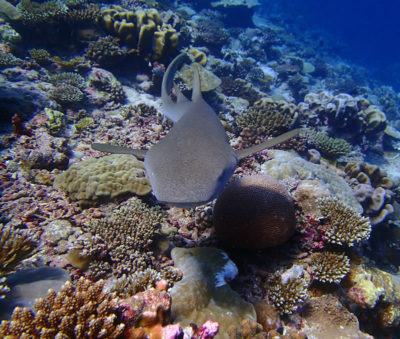
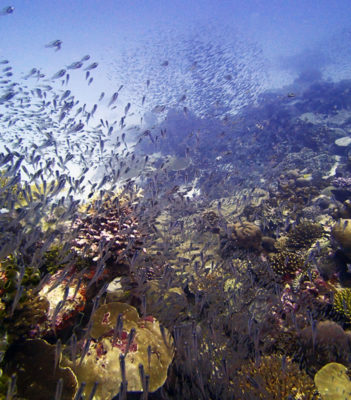
Healthy reefs in BIOT showed virtually no signs of past bleaching events.
(click-thru on images for greater detail)
We did occasionally find dead corals, but hard-bottom areas on the seafloor and dead skeletons were colonized by unusually high numbers of baby (recruits) and juvenile corals, suggesting that the older corals that died are quickly replaced. We also witnessed the onset of a major bleaching event. After nearly a month of warm temperatures and unusually calm conditions, corals began losing their color. Most corals had lost their normal shades of green, brown and golden brown and it looked like someone had dumped piles of colored popcorn onto the reef. Many of the corals had become stark white, while others were various shades of fluorescent yellow, blue, purple, and pink. In some of the most severely affected sites the corals had begun to die by the end of our research mission. Fortunately, in early May the weather patterns had begun to change as the southeast monsoon winds kicked in and waters from the depths began to move toward the shallows, bathing corals in cooler water.
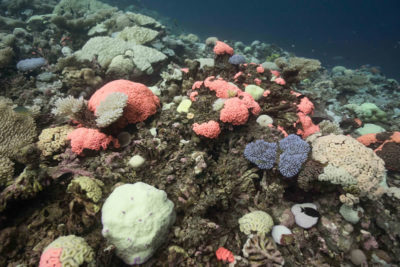
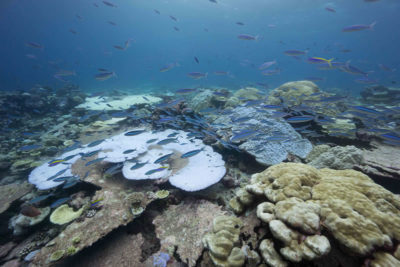
Corals turned cotton-candy colors as they began to bleach.
(click-thru on images for greater detail)
Although I focused my research on corals, I was frequently distracted by “charismatic mega fauna”. Curious green turtles, manta rays, reef sharks, and even the occasional whale shark, dolphin, and whale approached us as we were conducting our surveys.
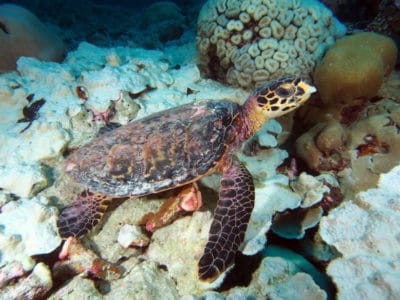
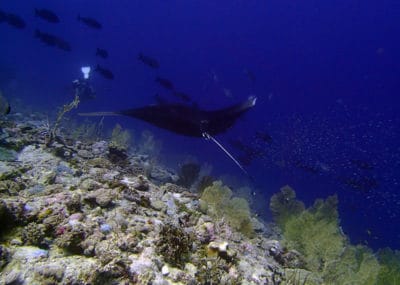
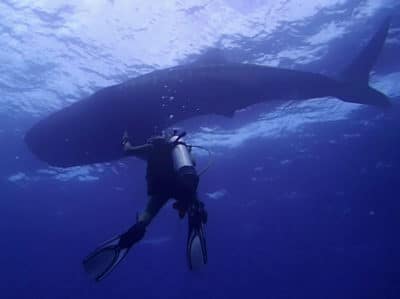
Green sea turtles, manta rays, and whale sharks were spotted on our coral reef surveys.
(click-thru on images for greater detail)
BIOT’s reefs also supported huge schools of snapper, jacks, surgeonfish and other species of reef fish – its waters thick with fish that moved en masse, like translucent “curtains” that made it hard sometimes to see the corals. By some estimates, the biomass of reef fish is reported to be at least six times that seen elsewhere in the Indian Ocean. The high biomass appears to be due mostly to large-bodied fishes – especially top predators. These species are reported to be much less common in the rest of the Indian Ocean, as they are highly vulnerable to fishing pressure. These fishes are also sensitive to disturbances. For instance, if the corals die and are broken or eroded, and the physical structure provided by the corals disappears, the diversity and abundance of fish will likely decline.
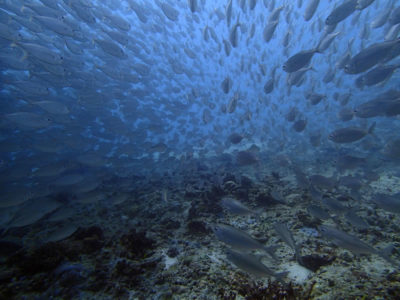
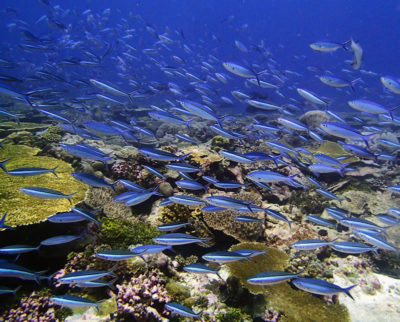
The reefs of BIOT were thick with clouds of fish.
(click-thru on images for greater detail)
The virtual absence of large accumulations of fleshy macroalgae (seaweed) and cyanobacteria (blue-green algae) was also noteworthy. In nearly every other country we examined during the Global Reef Expedition, large mats of seaweed and cyanobacteria carpeted the bottom, competing with the stony corals and preventing settlement and survival of coral recruits. The lack of algae at BIOT was probably due to the extremely low levels of nutrients, as well as high levels of herbivory. Parrotfish, surgeonfish and rabbitfish were extremely abundant and effective at keeping the seafloor free of harmful algae.

BIOT may be a final frontier for coral reefs in the Indian Ocean.
(click-thru on image for greater detail)
As we wrapped up our research, my thoughts turned once again to the incredible array of life we witnessed every day, during each of our 150+ dives. Out of all the sites we surveyed during the GRE, it is likely that the importance of BIOT is unparalleled. In a rapidly changing global environment, where human pressures continue to grow and stressors from climate change are predicted to worsen, BIOT may be a final frontier for coral reefs of the Indian Ocean. This is the only place in the Indian Ocean with a near absence of human threats. Species that have exhibited unprecedented declines elsewhere still remain robust and of a size reminiscent of bygone days on many other reefs. As a repository for threatened and endangered species and a storehouse of biodiversity, it is critical that these reefs continue to be protected. By working together, we can safeguard BIOT’s precious coral resources and ensure these majestic coral reefs and their associated marine life to continue to flourish.
Photos: 1-2 & 6-9 Anderson Mayfield, 3-4 & 10 Phil Renaud, 6 Andy Bruckner